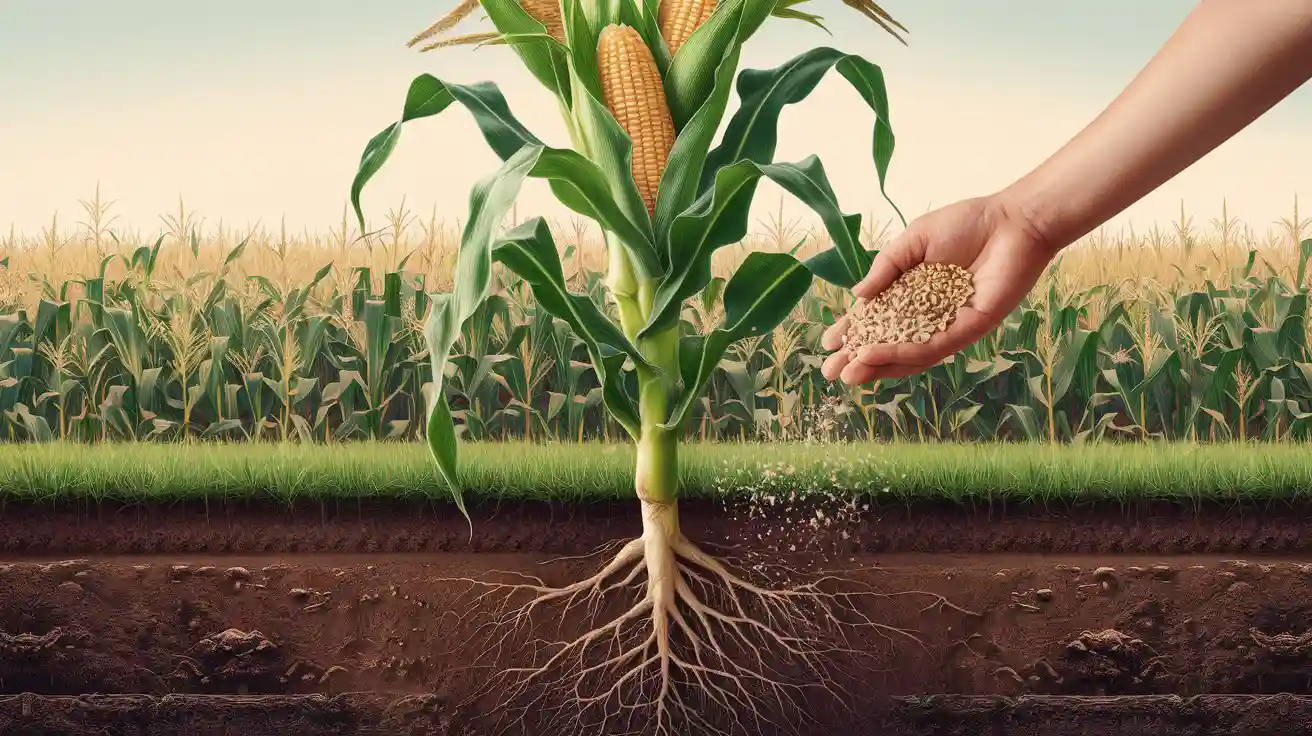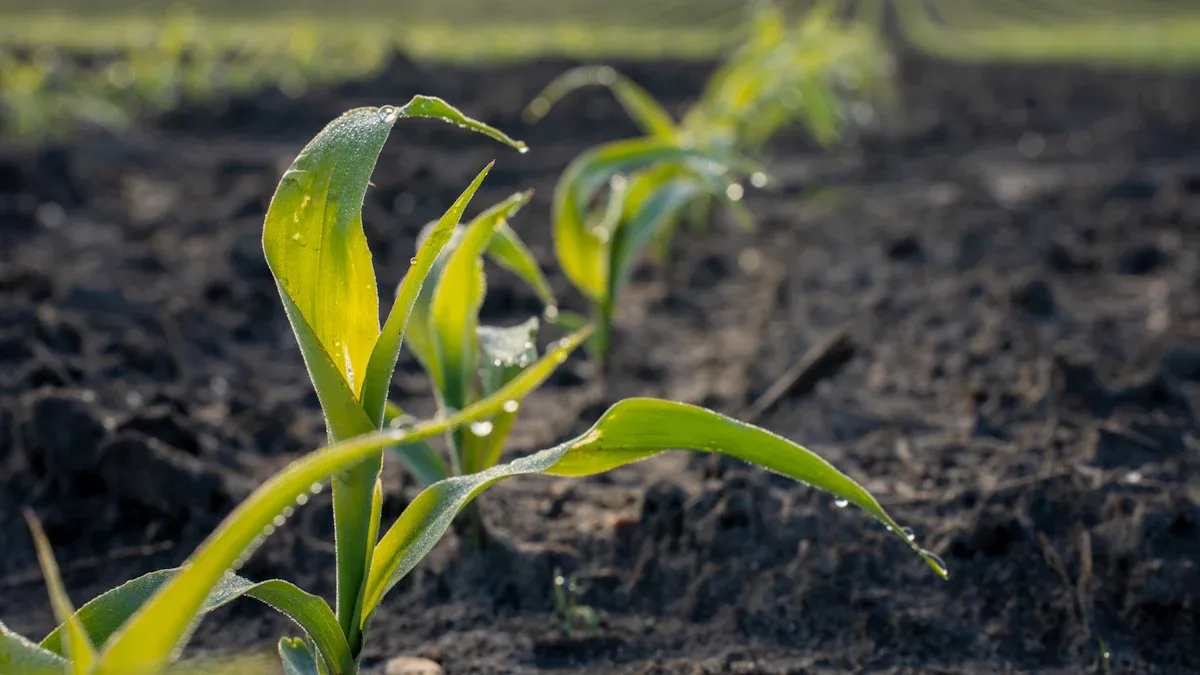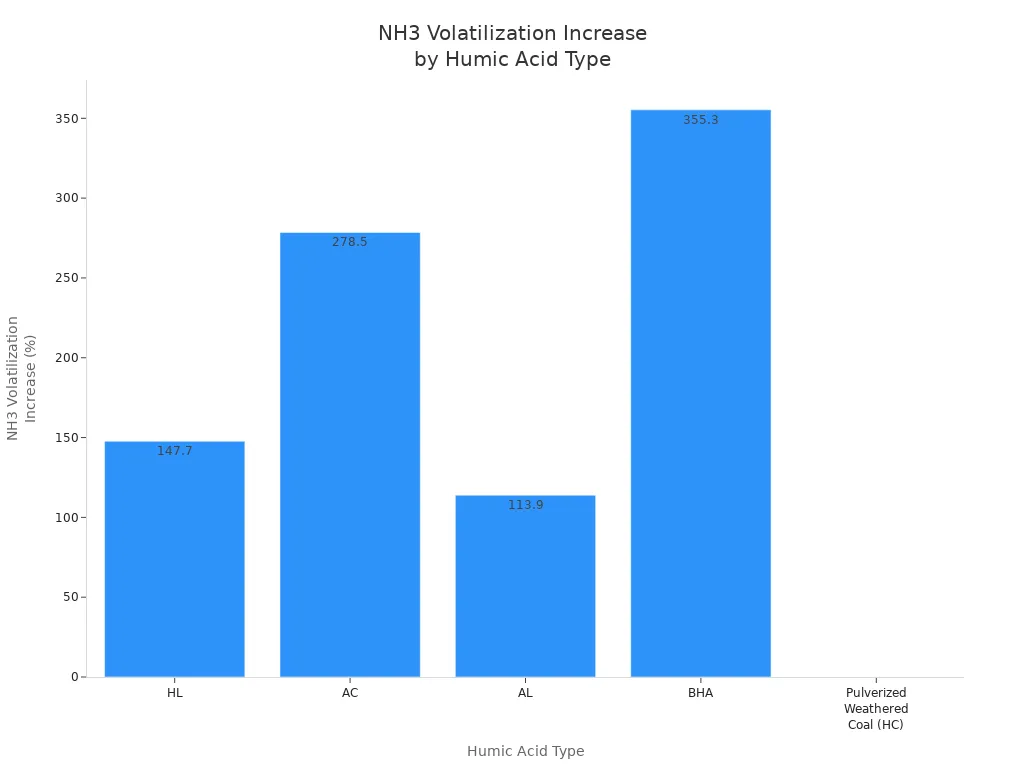Top Tips for Boosting Corn Yield with Humic Acid Fertilizer

You can see real benefits when you use humic acid fertilizer for corn at the right time. Early application works best because it helps the soil hold nutrients. Healthy soil lets corn roots grow deep and strong. When you treat the soil early, you notice more benefits in corn yield. The soil becomes rich in organic matter. Better soil structure means water moves well. You boost the benefits by improving soil texture. Corn plants get more from the soil. You notice the soil stays loose. Good soil helps you manage water better. Soil life increases, giving you more benefits.
Key Takeaways
Use humic acid fertilizer early in the season. This helps corn roots grow strong. It also helps them take in more nutrients.
Pick high-quality, organic humic acid products. These improve soil health. They also help good microbes in the soil.
Apply humic acid when you plant corn. Use it again during important growth times like V3 and V6. This gives the best results.
Mix humic acid with NPK fertilizers and biofertilizers. This helps corn take in more nutrients. It also makes the soil better.
Watch your corn’s growth often. Test the soil and plant tissue regularly. Change your fertilizer plan if you need to.
Do not make mistakes like using it at the wrong time. Mix it well and store it the right way. This helps you get all the benefits.
Use the right amount of humic acid. This protects the environment. It also saves you money on fertilizers.
Many farmers get bigger yields and stronger plants. Their soil is healthier when they use humic acid the right way.
Benefits

Nutrient Uptake
You want your corn to grow as much as it can. Humic acid fertilizer helps your corn take in more nutrients. When you use the right amount, corn can get more nitrogen, phosphorus, and potassium. Studies show humic acid makes nutrients easier for corn to use. It helps keep phosphate in the soil by changing it into a form corn can use. This makes phosphate fertilizer work better and helps your corn grow more. Humic acid also helps the soil keep important nutrients longer. Your corn gets food all season. This leads to better growth and bigger harvests when you focus on nutrient uptake with humic acid.
Tip: Use humic acid early in the season to help your corn keep and use more nutrients.
Root Growth
Strong roots help corn stay healthy. Humic acid fertilizer helps roots grow in many ways. You will see roots get heavier and cover more ground. Tests show humic acid helps enzymes work better so roots grow longer and stronger. These enzymes help roots push deeper into the soil. Humic acid also helps proteins that make roots stronger and help them handle stress. With better roots, corn can get more water and nutrients. This means your plants grow better and you get more corn. Healthy roots also help corn keep water and nutrients, which is important for good harvests.
Humic acid helps roots get bigger and cover more soil.
Corn can take in more water and nutrients.
Better roots help plants grow and give you more corn.
Soil Health
Soil health is important for big harvests. Humic acid fertilizer makes soil better by adding more organic matter and helping soil structure. When you use humic acid, the soil holds more water and nutrients. This helps plants grow because they get what they need. You will see more good activity in the soil, which helps helpful microbes and makes soil richer. Healthy soil keeps nutrients longer, so corn gets steady food. Better soil means stronger plants and more corn. Organic matter also helps air and water move through the soil, so roots can grow. When you care for soil health, you help your corn grow well for many years.
Note: Using humic acid often makes soil healthier, helps plants grow, and keeps more water in the soil for a long time.
Product Selection
Humic Acid Fertilizer for Corn
Picking the right humic acid fertilizer for corn helps your field. You need a product that keeps soil healthy and helps corn grow strong. Find humic acid fertilizer for corn with the right amount and high bioactivity. This helps soil keep more water and nutrients. You also want a product that helps good microbes in the soil. If you use certified organic products, you avoid fake chemicals and help organic farms. Organic humic acid fertilizer for corn makes soil less packed and more open. This lets roots grow deeper and stronger. It also helps soil keep more water and nutrients, so corn gets food and water all the time.
Pick humic acid fertilizer for corn with the right amount (0.005% to 0.01%).
Choose certified organic products for better soil.
Make sure the product makes soil more open and less packed.
Pick a fertilizer that helps good microbes and root growth.
Tip: Using organic humic acid fertilizer for corn keeps soil healthy and helps you get more corn.
Liquid vs Granular
You can choose liquid or granular humic acid fertilizer for corn. Each type helps your soil and corn in different ways. Liquid humic acid works fast. You can mix it with water and spray it on soil or leaves. This helps nutrients move quickly to the roots. Granular humic acid gives nutrients slowly. You spread it on the soil, and it works for a long time. Granular types are easy to use with other organic fertilizers. Both types help soil keep more water and nutrients. Pick the type that fits your farm and soil best.
Type | How to Use | Benefits for Soil | Best For |
|---|---|---|---|
Liquid | Spray or drench | Fast nutrient delivery | Quick results |
Granular | Spread on soil | Long-lasting effects | Steady soil improvement |
Note: Liquid types are good for quick help, but granular types help soil stay healthy for a long time in organic farms.
Quality Factors
You want the best when you pick humic acid fertilizer for corn. High purity and strong bioactivity help your soil and corn a lot. Look for products that meet world standards like ISO. These products help safe and green farming. Pick organic fertilizers with clear sources and how they are made. This helps you know the product is safe for soil and nature. Good factories make the product work better and hurt the earth less. Good brands check their products to keep them pure. When you pick a trusted brand, you help your soil and get more corn.
Pick humic acid fertilizer for corn with high purity and strong bioactivity.
Choose products that meet ISO or other world standards.
Look for organic fertilizers with clear sources.
Pick brands with good checks and new technology.
Tip: High-quality organic humic acid fertilizer for corn keeps soil healthy and helps corn grow strong and steady.
Application Timing
At Planting
When you use humic acid fertilizer for corn at planting, you help your corn grow strong. Early use gives your corn a good start by making nutrients easier to get. If you put humic acid in the furrow with the seed, roots can reach more nutrients right away. This helps plants grow fast and roots spread out quickly. Roots get deeper and stronger, so they take in more nutrients. Early use also makes the soil better, so water and air move easily. This gives corn the best place to get nutrients and grow well. You get more corn when you start with good soil at planting.
Tip: Put humic acid fertilizer for corn in the furrow at planting to help roots grow early and take in more nutrients.
Multiple Stages
You can get even more corn by using humic acid fertilizer at different times. Many farmers use it on seeds, in the furrow, and again when corn is growing new leaves like V3 and V6. Each time you use it, you help corn get more nutrients and grow better. Studies show that using it at V3 and V6 makes leaves bigger and plants stronger. These times are when corn needs the most nutrients to grow fast. You help corn take in more nutrients and keep it healthy by using humic acid at these times. Using it more than once also helps fill the kernels, so you get more corn. You give your corn the best chance to do well by helping it at every important time.
Use at planting for early root and shoot growth.
Treat seeds or use in the furrow for more nutrients.
Spray at V3 and V6 for the most growth and nutrient use.
Foliar Use
You can spray humic acid fertilizer on the leaves to help corn grow and take in more nutrients. Spraying on leaves gives nutrients right to the plant, so corn can use them fast. This works well when corn is growing quickly or when roots have problems. You see better growth and more nutrients in the plant after spraying. Spraying also fixes small nutrient problems fast, so your corn stays healthy. You help corn get what it needs and grow more by spraying at the right time. Always use the amount on the label and do not spray when it is hot or dry to keep leaves safe.
Note: Spraying humic acid fertilizer for corn on leaves helps plants take in more nutrients and grow strong, especially at important growth times.
Application Methods

Soil Application
The best way to use humic acid fertilizer is to put it right on the soil. This helps the soil hold more nutrients and stay healthy. When you add humic acid, roots can grow deeper and stronger. The soil gets looser, so air and water move better. This helps the soil keep water and nutrients for a longer time. If you treat the soil when you plant, corn grows better from the start. Many farmers put humic acid in the furrow with the seed. This puts nutrients close to the roots, so young corn can use them fast.
Tests show that using Yield Igniter® at about 1.5 gallons per acre, mixed with water, and sprayed on the soil early, helps corn leaves get bigger and plants grow better. The soil does best when you use humic acid before the V6 stage. Do not mix humic acid with very alkaline products. This keeps the soil healthy and makes sure the humic acid works well.
Tip: Put humic acid on the soil early in the season. This helps the soil stay healthy, keeps more water, and helps corn grow strong.
Foliar Application
Foliar application means spraying humic acid on the leaves. This helps corn get nutrients fast, especially when the plant is growing quickly or the soil is stressed. You can use farm sprayers to spray a weak mix on the leaves. Spraying works best from V3 to V6, when corn needs more food to grow fast. The leaves take in the humic acid, which helps the plant use more nutrients and grow well.
In tests, farmers got 4.9% more corn when they used liquid humic acid in the furrow at planting and sprayed it on the leaves four weeks later. This helped the soil keep more nutrients and helped plants recover from stress. Do not spray when it is hot or dry, so the leaves do not get hurt and the soil does not lose water. Always follow the label for mixing and spraying.
Note: Spraying humic acid on leaves gives corn a quick boost, especially when the soil cannot give enough nutrients or water.
Rates and Frequency
You need to use the right amount and timing for humic acid fertilizer to help your corn. Most tests say to use 1 to 3 gallons per acre, depending on your soil and crop. Change the amount if your soil has more or less organic matter or if your field needs something special. Using humic acid early and more than once works best. Start at planting, then use it again at important times like V3 and V6. This helps roots grow, helps corn get more nutrients, and keeps water in the soil all season.
Here is a table that shows good ways to use humic acid from tests:
Aspect | Details |
|---|---|
Product | Yield Igniter® humic product (alkaline extracted leonardite ore) |
Application Rate | About 3.5 liters per hectare (about 1.5 gallons per acre) |
Dilution | Mix with water at about 94 liters per hectare |
Application Method | Spray with farm sprayers at 207-310 kPa pressure |
Timing | Early growth: preemergence, V3, V5, V6; not after V6 |
Crop Response | Bigger leaves and better plant growth seen |
Watch your soil and plant leaves to see how your corn is doing. Change the amount if you see your corn needs more nutrients or the soil is not holding them well. Do not use humic acid when it is raining a lot or the soil is too wet, because it can wash away and not help. Ask an expert if you are not sure how much to use for your soil.
Pick humic acid that fits your soil and corn.
Use it at seed sprouting, early growth, and before flowering.
Check soil and leaf nutrients to make your plan better.
Use humic acid early and often for better soil and corn.
Callout: Using humic acid at the right time and rate helps your soil keep nutrients, keeps more water, and helps corn stay healthy all season.
Integration
With NPK Fertilizers
You can get more corn by using humic acid with NPK fertilizers. This mix makes your soil better and helps plants use food from the soil. Humic acid helps the soil keep more nutrients. Your corn gets more nitrogen, phosphorus, and potassium when it needs them. Humic acid also helps plants take in these nutrients. This makes your corn grow faster and stronger.
Here is a table that shows how humic acid helps fertilizers work better for corn and soil:
Aspect | Evidence Supporting Humic Acid Integration with Fertilizers for Corn Yield Enhancement |
|---|---|
Soil Physical Properties | Humic acid with vermicompost made soil macroaggregates bigger by 77.59–125.58%. It lowered salt in the soil and made the soil structure better in salty areas. |
Nutrient Uptake Timing | Corn took in more nitrogen during early growth (6-leaf stage). Corn took in more phosphorus and potassium during later growth (tasseling and harvest). |
Microbial Community Regulation | Humic acid changed the microbes near the roots. It helped good bacteria (Proteobacteria, Actinobacteria, Acidobacteria) and fungi (Ascomycota) grow. This made more nutrients for corn. |
Yield Impact | These changes helped corn take in more nutrients and grow better in salty soil. Corn yield went up. |
Implication for NPK Fertilizers | The study used humic acid with vermicompost. But the results show humic acid can help NPK fertilizers work better for corn. |
When you use humic acid with NPK, you may need less chemical fertilizer. This saves money and keeps your soil healthy. The soil holds more organic matter, which helps your field grow corn for many years.
Tip: Add humic acid to your NPK plan to help your soil keep nutrients and grow more corn.
With Biofertilizers
You can get even better corn by using humic acid with biofertilizers. Biofertilizers add good microbes to the soil. These microbes break down organic matter and give food to your corn. Humic acid helps these microbes grow and work better. This makes the soil richer and helps corn roots get more food.
Humic acid makes the soil softer, so roots can spread out and take in more nutrients. Your corn gets food all season because the soil keeps nutrients longer. Using both humic acid and biofertilizers adds more organic matter and helps the soil stay healthy. This gives you stronger corn plants and more corn.
Use humic acid and biofertilizers together for better soil.
Help the soil by adding more organic matter and good microbes.
Make sure your corn gets enough food and grows well.
Note: Mixing humic acid with biofertilizers makes the soil healthy and helps you grow more corn.
Soil pH and Fertility
You need to check your soil pH and fertility to get the most from humic acid fertilizer. If the soil is too acidic, corn cannot use nutrients well. Studies show that raising soil pH from about 5.03 to almost 6.66 with humic substances, biochar, and NPK makes soil much better. You get more organic matter, nitrogen, and phosphorus. More good microbes live in the soil, which helps corn grow.
Soil with the right pH keeps more nutrients for your corn. You also have fewer heavy metal problems and safer plants. Always test your soil before you plant. Change the pH and fertility if needed to help corn take in and keep nutrients.
Callout: Keep your soil pH close to neutral and add organic matter for the best results with humic acid fertilizer. This helps your soil stay healthy and gives you more corn.
Monitoring
Crop Response
You need to watch your corn closely after you apply humic acid fertilizer. Look for changes in plant color, leaf size, and root growth. Healthy corn shows deep green leaves and strong stalks. You may see faster growth and more even stands. If you notice weak plants or yellow leaves, check your soil and review your fertilizer plan. Good crop response means your soil supports strong roots and steady growth. You want to see corn that stands tall and resists stress. When you use organic humic acid, you often see better water use and less wilting. Strong crop response tells you that your soil and organic matter work well together.
Tip: Keep a field notebook. Write down what you see each week. This helps you spot trends and make better decisions.
Soil and Tissue Testing
You can use soil and tissue testing to track how well your humic acid fertilizer works. These tests give you real data about your soil and your corn’s nutrient status. Regular testing helps you understand how your soil changes over time and how organic inputs affect nutrient levels.
Soil testing shows you the levels of nutrients and the health of your soil. You learn how humic acid changes nutrient availability and soil structure.
Tissue testing gives you a snapshot of the nutrients inside your corn at different growth stages. You can spot problems early and fix them before yield drops.
Combine both tests to see how well your corn uses nutrients from the soil and organic fertilizer.
Take samples from at least 20 plants in both healthy and problem spots. This gives you a clear picture of your field.
Compare tissue test results to standard nutrient ranges. You will know if your corn has enough, too little, or too much of each nutrient.
Test your soil and plants several times during the season. This helps you track changes and adjust your plan.
Use the results to guide your fertilizer choices and improve your soil and crop quality.
Note: Consistent soil and tissue testing helps you use organic and humic acid fertilizers more effectively. You save money, protect the environment, and grow better corn.
Adjusting Practices
You should adjust your practices based on what you learn from monitoring. If your soil tests show low organic matter, add more organic amendments. When tissue tests show a nutrient shortage, change your fertilizer rate or timing. Use the data to fine-tune your plan for the next season.
Increase organic inputs if your soil needs more structure or water-holding ability.
Change your humic acid application if you see weak crop response or poor nutrient uptake.
Rotate crops and use cover crops to keep your soil healthy and full of organic matter.
Watch for signs of soil compaction or erosion. Fix these problems quickly to protect your soil.
Keep records of all changes. Review them each year to see what works best for your soil and corn.
Callout: Smart adjustments help you get the most from your soil, organic matter, and humic acid fertilizer. You build a strong foundation for future corn crops.
ROI and Mistakes
Return on Investment
You want to get the most out of your humic acid fertilizer. Checking your return on investment (ROI) helps you know if your plan works. First, write down what you spend on humic acid and how you use it. Also, note any changes in your fertilizer plan. Then, compare these costs to the extra corn you grow. Many farmers see they can use less nitrogen fertilizer with humic acid. This saves money and keeps more nutrients in the soil. Humic acid also helps the soil hold water and nutrients longer. This helps your plants stay healthy. If you use humic acid at the right time and amount, you often get stronger plants and bigger harvests. Always look at your notes each year to see if your changes help you earn more.
Tip: Keep a simple notebook with your fertilizer costs, soil test results, and harvest numbers. This helps you track your ROI and make better choices next year.
Common Errors
Using humic acid fertilizer can help your corn, but mistakes can lower the benefits. Experts have found some common errors you should not make. The table below lists these mistakes and tells how they hurt your soil and corn:
Common Mistake | Explanation |
|---|---|
Incorrect Dosage and Timing | Using humic acid during bad weather or not during growth makes nutrients wash away and work less. Use it when corn is growing. |
Improper Dilution or Mixing | Humic acid must be mixed right for your crop, soil, and watering system. Wrong mixing wastes product or makes it work less. |
Compatibility Issues | Mixing humic acid with very acidic or calcium-rich fertilizers can stop it from working or clog your system. Test if they work together first. |
Improper Storage | High heat or sunlight can ruin humic acid. Store it in a cool, shady place to keep it good. |
Lack of Soil Analysis | Not testing your soil means you may use the wrong amount or time. Test your soil to match your plan to what it needs. |
You should also not use too much fertilizer, use the wrong kind, feed at the wrong time, forget to water, or ignore soil health. Always follow the label and change your plan if soil tests say so.
Environmental Cautions
Using too much humic acid fertilizer can hurt the environment. Some types make a lot more ammonia (NH3) escape into the air. This means less nitrogen for your corn and more air pollution. Some products also make more carbon dioxide (CO2), which can change the climate. The chart below shows how different humic acid types change ammonia loss in corn fields:

Pick humic acid products that are safer for the environment. Pulverized weathered coal types are the safest. Always use the amount on the label and do not use before heavy rain. This keeps nutrients in the soil and protects water and air.
Note: Using humic acid fertilizer the right way keeps your soil healthy and protects the environment for future crops.
Success Stories
Farmer Results
Farmers see big changes in their corn fields with humic acid fertilizer. Many farmers have shared what happened when they used it:
Corn yields can go up by as much as 15% in just one season after using humic acid fertilizer.
Corn roots get stronger and grow deeper, so plants take in more nutrients.
Soil gets better and holds water longer, which helps in dry times.
Some farmers use less chemical fertilizer after switching to organic humic acid products.
Corn plants get tougher and fight off stress and disease better.
Studies show humic acid helps corn take in more phosphorus and helps good microbes grow in the soil. These changes make corn stronger.
Using humic acid early, from before sprouting to V6, gives corn a great start.
Mixing humic acid with biochar or other organic things can make corn even better and help it handle stress.
Tip: Many farmers say organic humic acid fertilizer not only grows more corn but also makes crops better and soil healthier for the next year.
Field Trials
Field trials in many places show humic acid fertilizer really helps corn grow. You can get 5% to 20% more corn when you use humic acid, based on big studies of biostimulants. These tests also show corn takes in more nutrients, roots grow stronger, and soil holds more water. These things help corn fields do better.
One test used a pH-stable liquid humic acid called Huma Pro® Mix. Corn yield went up by 4.9%, which is about 6.7 more bushels per acre than regular fertilizer. This product also gave a 30% better return on investment. Not all products work the same, so pick your organic humic acid carefully.
In the Midwest, field trials showed small but good increases in corn yield, usually between 1% and 4%. On-farm checks found corn grain weight went up by 6.5% in most test strips. You will see longer corn ears and bigger leaves, which means better crops. These gains are bigger in fields that started with lower yields and in dry weather. You might not see the same results in wet fields or every year, but most tests show organic humic acid fertilizer helps corn do better.
Note: Field trials show organic humic acid fertilizer can help you grow better corn and get higher yields, especially if you use it at the right time and in the right way.
You can get more corn by using humic acid fertilizer the right way. It is important to use it at the best times and watch your plants closely. Put it on early and again at different times for the most help. Mix humic acid with NPK and biofertilizers to help your corn get more food and make the soil better. Try it on a small part of your field first to see how it works. Change your plan to fit your soil and weather for the best results.
Remember: Keep checking your corn and pick the best product to get all the good things from humic acid fertilizer. Make your plan now to grow more corn next season!
FAQ
How often should you apply humic acid fertilizer to corn?
Apply humic acid when you plant corn. Use it again when corn is growing new leaves, like at V3 and V6. This helps corn get the most from the fertilizer.
Can you mix humic acid with other fertilizers?
You can mix humic acid with NPK and biofertilizers. Always read the label to make sure they work together. Mixing them helps corn use nutrients better.
Is humic acid safe for organic farming?
Humic acid is good for organic farming. Pick certified organic products to follow the rules. These products help soil stay healthy and fit organic plans.
What is the best way to apply humic acid to corn?
Put humic acid on the soil, in the furrow at planting, or spray it on leaves. Using it on the soil at planting helps roots grow and take in more nutrients.
Will humic acid fertilizer increase corn yield every year?
You might get more corn most years, especially if your soil is poor or has little organic matter. Results can change with weather and soil. Watch your corn to see how it does.
Can you use too much humic acid on corn?
Using too much wastes money and can hurt the environment. Always use the amount on the label. Using the right amount helps your soil and corn.
How do you know if humic acid is working?
Look for darker green leaves, stronger roots, and better growth. You can also test your soil and plants to check nutrients and soil health.
Does humic acid help in dry weather?
Humic acid helps soil keep more water. Corn can handle dry times better because the soil holds moisture longer.
